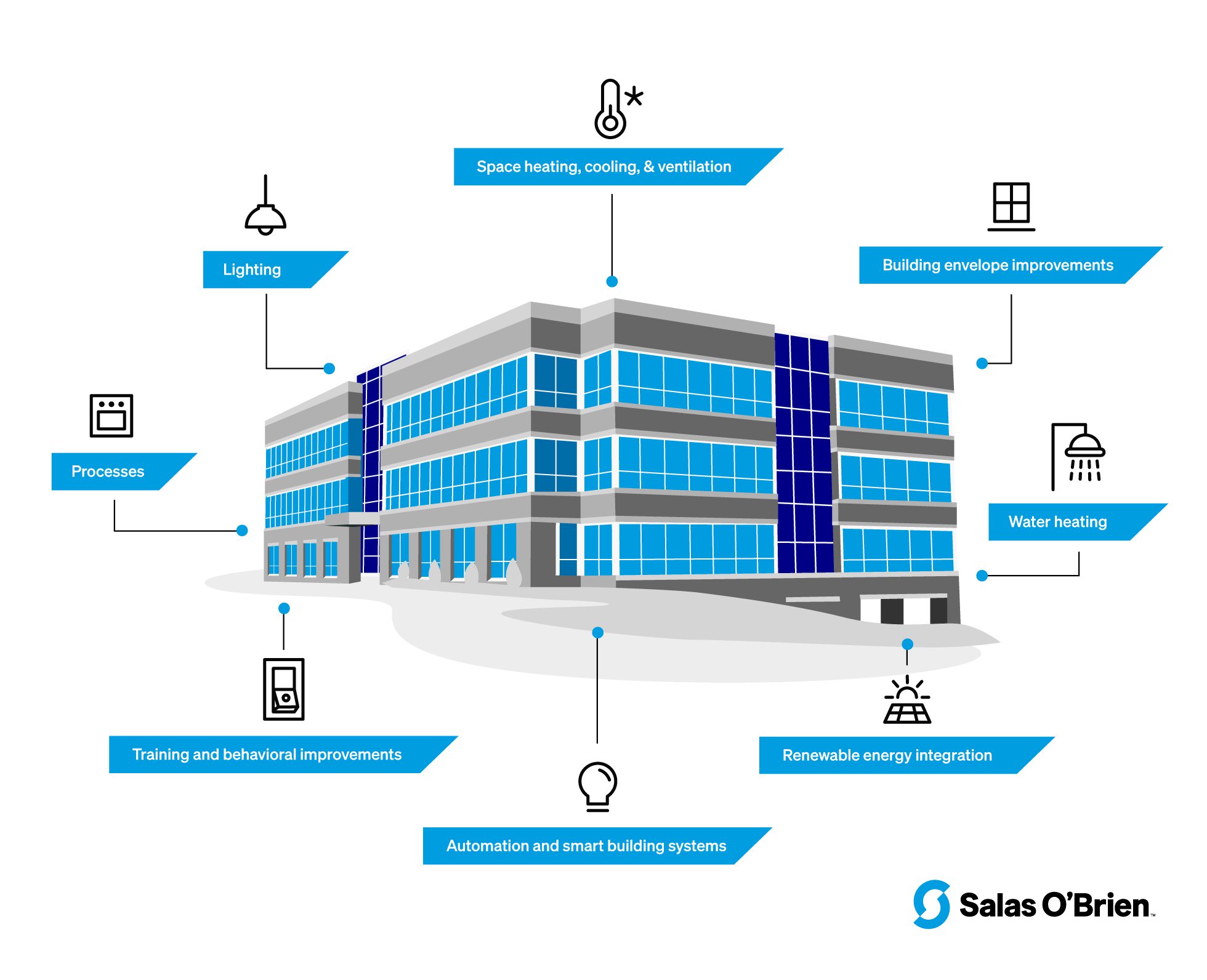News & Insights
A building owner’s guide to electrification of existing systems
Electrification of existing buildings is a key step towards decarbonization. This guide serves as a roadmap for building owners to navigate through the intricacies of retrofitting with clarity and foresight.

What is electrification (and why does it matter for existing buildings)?
Electrification in the context of existing buildings refers to the process of transitioning the building’s energy sources from fossil fuels to electricity. This shift is primarily aimed at heating, cooling, and operating systems which traditionally relied on natural gas, oil, or coal. The rationale behind this transition is grounded in a commitment to sustainability that aims to reduce carbon emissions, enhance energy efficiency, and improve indoor environmental quality.
According to the US Environmental Protection Agency (EPA), greenhouse gas (GHG) emissions from the commercial and residential sectors make up about a third of annual GHG emissions. The electrification of these buildings works to reduce the fossil fuels burned for heating and cooling in existing buildings, accelerating decarbonization nationwide.
Why would a building owner consider this investment?
While the upfront cost of electrifying a building or campus can be considerable, the long-term benefits—ranging from economic to environmental and regulatory—make it a worthwhile consideration. These advantages help ensure that the property remains competitive, valuable, and sustainable as a long-term asset.
As a building owner, here’s why you might consider this investment:
- Lower operating costs. Electric heating and cooling systems tend to be more efficient than their fossil fuel counterparts and can result in significant savings on energy bills. Additionally, electric systems generally require less maintenance than combustion-based systems, further reducing long-term costs.
- Regulatory compliance and incentives. As governments and regulatory agencies intensify efforts to reduce carbon emissions, regulations targeting building emissions are becoming stricter. Many cities—such as NYC—are implementing legislation to drive more sustainable behavior. By upgrading to electric systems now, you’re future proofing your investment against more drastic changes required later, potentially at a higher cost and under more pressing regulatory deadlines. Moreover, many local and federal governments offer incentives for building electrification, such as tax breaks, rebates, and grants, which can help offset the initial investment.
- Improved indoor environment quality. Electric systems do not produce the indoor pollutants that are often associated with burning fossil fuels, such as carbon monoxide and nitrogen oxides. This significantly improves the air quality inside the building, leading to a healthier living environment. Better air quality can reduce occupant complaints and liabilities.
- Consumer demand. Buildings with modern, efficient electrical systems are more attractive to prospective buyers and tenants. Electrification can increase your property’s market value and desirability because it aligns with growing consumer preferences for greener, more sustainable spaces, which can help attract talent, tenants, students, patients, or investors.
What usually drives a building owner to begin the electrification process?
While the concept of electrification might be part of a long-term strategic plan, the actual decision to initiate the process is often reactive rather than proactive. Typically, building owners are prompted to start the electrification process due to immediate, practical concerns.
One of the most common catalysts for electrification is the failure of existing, outdated fossil fuel-based systems. For instance, when a boiler or heating system becomes too costly to repair—owing to age, inefficiency, or both—owners are faced with a decision. Rather than further investing in outdated technology with high operational costs and environmental impacts, they often choose to switch to more modern, efficient electric alternatives.
Changes in local or national regulations can also precipitate the shift towards building electrification. The introduction of carbon emissions regulations, including set emissions limits and financial penalties for exceeding the limit, can render the ongoing operation of older systems economically untenable. As fines accumulate and the prospect of even stricter future regulations looms, building owners often view electrification as both an environmentally responsible and economically strategic response.
Electrification undertaken before these precipitating events can provide numerous advantages. Proactively transitioning to electric systems allows building owners more control over the process, enabling a smoother changeover and better financial planning. This foresight can mitigate the disruption typically associated with emergency system replacements and ensure compliance with regulatory changes without the pressure of immediate deadlines.
A roadmap for building owners considering electrification projects
Electrification projects often begin with a focus on upgrading a single system. However, adopting a broader perspective can significantly amplify the benefits. By establishing a comprehensive baseline and incorporating strategic energy management and behavioral changes, you can multiply the effects of their efforts, reducing emissions substantially and creating operational efficiencies that impact the bottom line.
Here’s a roadmap for a holistic approach to building electrification:
1. Start with your usage baseline and benchmark
Understanding your current energy use is the foundation of any effective electrification strategy. Begin by analyzing your energy bills; this practical step provides immediate insights into your building’s energy consumption patterns.
Utilize tools like the Energy Star® Portfolio Manager®, an interactive energy management tool that allows you to benchmark the energy use of any type of building. This resource helps identify underperforming buildings—prime candidates for efficiency improvements—and enables you to draw on best practices from efficiently managed properties. For more information, visit the Energy Star Portfolio Manager.
If you’re working with a professional team, the process will start with what’s known as “business as usual” development. During this phase, the team will gather comprehensive data to understand the project’s scope, including current assets, expenditure, and energy use, and create thermal profiles and models that depict the existing conditions.

2. Find opportunities for improvement
Identifying systems that can transition to electric power is a key step in the electrification process. Consider the following areas:
- Water heating. Transitioning to electric water heaters, especially high-efficiency models like heat pump water heaters, can significantly reduce energy use.
- Space heating, cooling, and ventilation. Implementing electric solutions such as heat pumps offers more efficient heating and cooling, replacing less efficient gas-fired systems. Upgrading to electrically powered, energy-efficient ventilation systems can improve indoor air quality and reduce energy use. Heat recovery ventilation (HRV) systems are particularly effective in climates that require significant heating and cooling.
- Electrify specific operational processes, such as cooking and industrial processes, depending on the building type. This also includes replacing older equipment with high-efficiency electric models.
While not strictly “electrification,” there are other elements to consider as part of this process to help with the overall energy efficiency of the building:
- Building envelope improvements. Enhancing the building’s envelope with better insulation, high-quality windows, and efficient doors can significantly reduce heating and cooling demands, making electrification more effective and reducing overall energy consumption.
- Renewable energy integration. Integrating renewable energy sources, such as solar panels or wind turbines, complements electrification efforts. This not only helps power electrified systems sustainably but also provides energy independence and resilience against grid instability.
- Upgrading to high-efficiency LED lighting systems drastically reduces electricity usage for lighting. Smart lighting systems that adjust based on natural light availability and occupancy can further enhance energy savings.
- Automation and smart building systems. Implementing building automation systems (BAS) for energy management can optimize the operation of heating, cooling, lighting, and other systems. Energy management software can adjust settings based on real-time data, further improving efficiency.
- Training and behavioral improvements. Older buildings often have workarounds like propping doors open, overriding automated systems manually, or inefficient usage patterns like leaving lights on in unoccupied spaces. Educating occupants and staff about energy-efficient practices can pay big dividends.
3. Identify the most effective strategies and build your plan
Once you have a comprehensive understanding of your energy usage and have pinpointed the areas for improvement, the next step is to prioritize these opportunities based on their potential impact and feasibility. Develop a phased plan that addresses the most critical upgrades first, especially those that offer the quickest payback in terms of energy savings and operational improvements.
- Develop a phased implementation plan. Start with projects that require minimal disruption and provide substantial benefits. For instance, lighting upgrades and behavioral changes can be implemented relatively quickly and provide immediate results.
- Plan for larger system overhauls. Larger projects can be planned during major renovation cycles or when existing systems are near the end of their operational life.
- Seek funding and incentives. Explore opportunities for funding and incentives available for energy-efficient upgrades and renewable energy integration. This financial support can significantly offset initial costs and accelerate the return on investment. These may include tax rebates, grants, and other financial incentives designed to encourage sustainable investments in building infrastructure.
- Monitor and adjust. Establish monitoring mechanisms to track the performance of implemented strategies. Regular reviews can help fine-tune operations and make necessary adjustments to ensure maximum efficiency and sustainability.
By following these steps, you can effectively navigate the complexities of building electrification, ensuring a strategic approach that not only enhances building performance but also contributes to broader environmental goals.
How is the return on investment (ROI) calculated for electrification projects?
Calculating the return on investment (ROI) for building electrification projects involves a detailed analysis that extends beyond simple cost comparisons. To understand the financial viability of such an initiative, several key factors are considered:
- Energy cost savings. Electrification typically involves replacing older, less efficient fossil fuel-based systems with modern electric solutions that not only consume less energy but also operate more effectively. This shift not only reduces energy consumption but also the costs associated with energy waste. Strategic energy management and behavior changes further enhance these savings, as they involve using energy more thoughtfully and efficiently.
- Incentive opportunities. Financial incentives such as rebates, tax breaks, and grants, particularly those under initiatives like the US Inflation Reduction Act (IRA) which is solid through 2035, play a crucial role in making the upfront costs of electrification more manageable. These incentives can significantly alter the ROI equation by offsetting initial expenditures and accelerating the payback period.
- Risk management. By switching to electricity, particularly that generated from renewable sources, buildings become less exposed to fluctuations in fuel prices and regulatory risks. This reduced exposure is an essential factor in the financial analysis where the value of mitigating these risks must be quantified.
Ultimately, the ROI of building electrification is determined by weighing these energy savings and risk reductions against the costs of implementing the new systems. This calculation not only assesses the direct financial benefits but also considers the broader impact on the building’s operational efficiency, regulatory compliance, and environmental footprint.
How Salas O’Brien can help
Embarking on a building electrification project can be a complex and daunting endeavor. Salas O’Brien is here to guide you through every step of this transformative journey, ensuring that your project aligns with both your sustainability goals and business objectives. Here’s how we can assist:
- Expert consultation and planning. Our team of experienced engineers and consultants understands the nuances of building electrification. We begin by assessing your current infrastructure and energy usage to provide a tailored, strategic plan that addresses your specific needs and goals.
- Detailed energy audits and modeling. We conduct comprehensive energy audits and utilize advanced modeling techniques to identify the most effective opportunities for energy savings and system improvements. This data-driven approach helps in making informed decisions that optimize performance and cost efficiency.
- Design and engineering services. Salas O’Brien offers full-service design and engineering solutions tailored to the unique requirements of your building or campus. Whether it’s retrofitting existing building systems or designing new installations, our expertise ensures that all technical aspects are handled with precision and care, ensuring compliance with all relevant standards and regulations.
- Project management and implementation. Our project management teams oversee the entire electrification process. We coordinate with all stakeholders, manage contractors, and handle logistics, making the transition as smooth and efficient as possible.
- Incentive and grant acquisition. Understanding the financial landscape of building electrification, Salas O’Brien can help clients navigate the complex world of incentives and grants. We assist in identifying and applying for applicable financial programs that can help offset the upfront costs of electrification projects, enhancing the economic feasibility of your investments.
- Ongoing monitoring and commissioning. After project completion, Salas O’Brien can provide support in system optimization, energy management, and continuous performance monitoring to ensure that your electrification investments deliver the expected benefits over their lifecycle.
Want to talk more about your project? Please reach out to one of our experts below.
For media inquiries on this article, reach out to Stacy Lake, Director of Corporate Communications.

Eleanore Colton
Eleanore Colton combines her expertise in environmental policy and energy consulting as the Energy Planning and Sustainability Coordinator at Salas O’Brien. She is approaching 5 years of experience working in the sustainability field, following 5 years of study which culminated in an MS in Sustainable Communities and a BA in Environmental Studies from Binghamton University. Prior to joining Salas O’Brien, Eleanore worked at a clean energy non-profit advocating for a just energy transition and sustainable community projects. Working on both the planning side of projects as well as the design and implementation side, she is dedicated to advancing sustainable practices within the firm and beyond. Eleanore excels at organizing and communicating data, researching and applying for external funding, and coordinating teams and projects specializing in decarbonization work. Contact her at: [email protected].

Andrea Sojda, PMP
Andrea Sojda is a professional consultant with 17 years of experience in managing intricate projects and programs across the Private, Public, and Federal sectors. She specializes in sustainable development, energy transition, environmental justice, community partnerships, natural resource management, operations, and effective stakeholder engagement. Andrea utilizes her unique background in compatible land development, commercial construction, and complex stakeholder management to provide the best solutions for her clients’ most challenging problems. Much of her career has been dedicated to working with communities globally. From her service as a United States Peace Corps Volunteer in Sub-Saharan Africa to her work in developing public-to-public partnerships across America, a consistent theme in her work is building sustainable communities. Currently, Andrea holds the position of Principal, Energy and Sustainability – Federal Market at Salas O’Brien, operating from Northern Colorado.Contact her at [email protected].